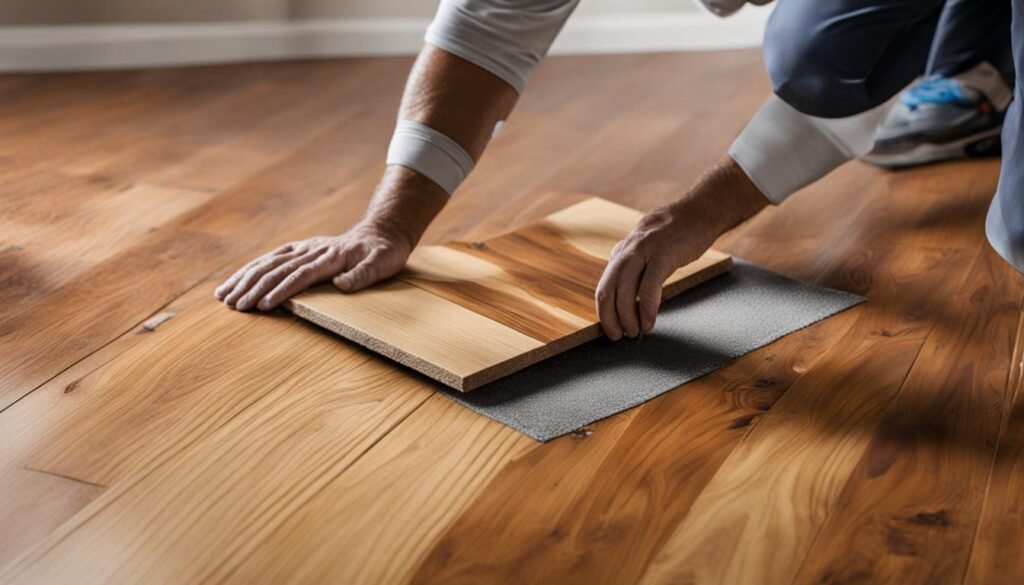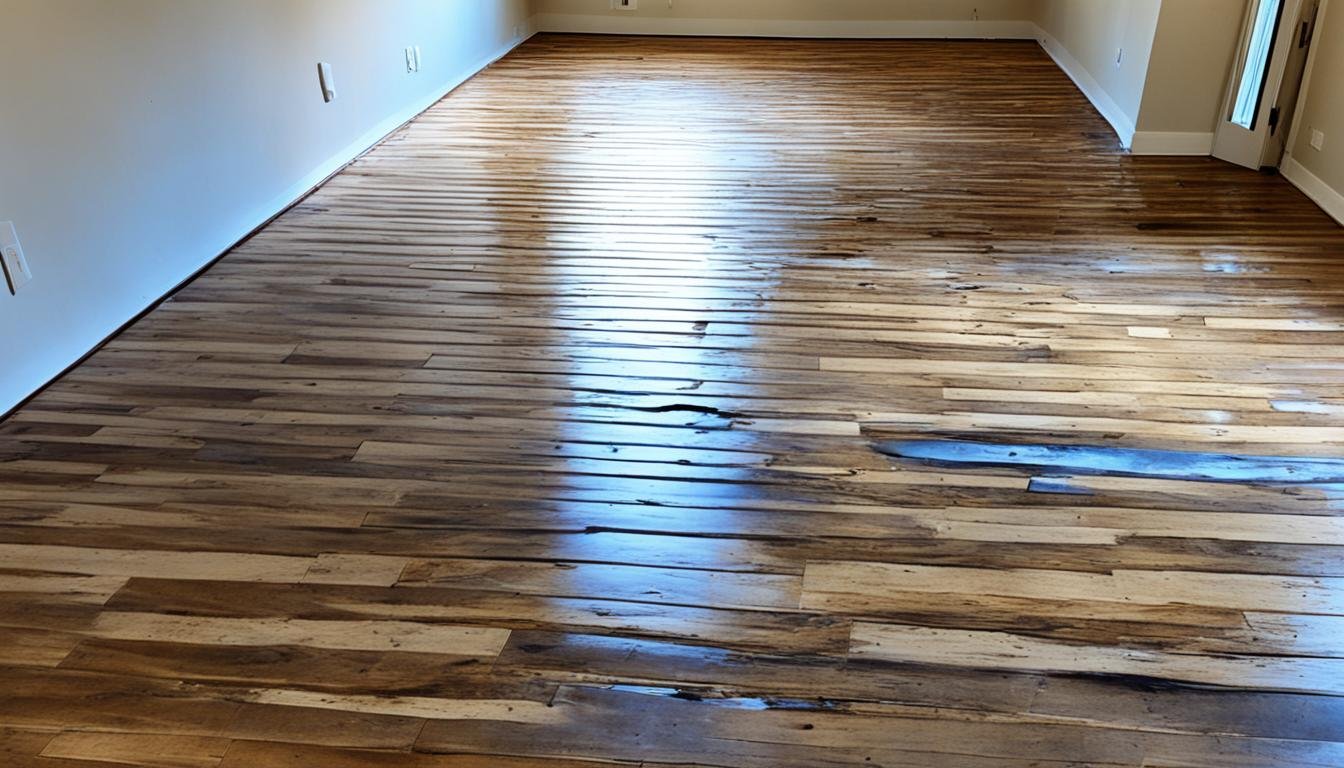Water damage on wood floors can have devastating effects, leading to discoloration, warping, and structural damage. If you’re dealing with floor water damage in San Bernardino, it’s crucial to understand the restoration and prevention techniques that can help salvage your wood floors and protect them from future damage.
When facing water damage, the first step is to assess the severity of the situation. Look for signs of buckling or warping, inspect for discoloration or staining, and check for any mold or mildew growth. Once you’ve determined the extent of the damage, it’s essential to take immediate action to minimize further harm.
Read More
Key Takeaways:
- Water damage on wood floors can lead to discoloration, warping, and structural damage.
- Assess the severity of the water damage by checking for signs of buckling, discoloration, and mold growth.
- Take immediate action to stop the source of water, remove standing water, and dry the area.
- Prevention techniques include maintaining consistent humidity levels, cleaning up spills promptly, and using protective mats and rugs.
- If the damage is extensive or involves specialty wood flooring, seeking professional help is advisable.
How to Repair Water-Damaged Hardwood Floors
When faced with water damage on your beautiful hardwood floors, prompt action and appropriate repair techniques are crucial to prevent further damage and restore their original beauty. Here are the steps you need to take to fix water-damaged hardwood floors:
- Assess the damage: Begin by evaluating the extent of the water damage. Is it localized or widespread? This assessment will help determine the appropriate course of action.
- Remove excess water: If there is standing water on the floor, use a mop or towels to soak up as much water as possible. Be thorough and ensure the area is dry before proceeding.
- Inspect the floor: Carefully examine the affected area for any signs of damage such as warping, cupping, or discoloration. Take note of any boards that may need to be replaced.
- Replace damaged boards: If the water damage has caused irreparable harm to specific boards, carefully remove them and replace them with new ones that match the existing flooring.
- Sand and refinish: Sanding the affected area will help remove any remaining stains and smooth out the surface. After sanding, apply a suitable finish to restore the floor’s luster.
- Color blending: If necessary, blend the color of the repaired area with the surrounding flooring to achieve a seamless appearance. A professional can assist you with color matching techniques.
- Prevent future damage: Implement preventive measures to protect your hardwood floors from future water damage. These can include using rugs or mats in high-risk areas, promptly cleaning up spills, and maintaining a consistent indoor humidity level.
Remember, the efficacy of repairing water-damaged hardwood floors depends on the extent of the damage and how quickly you take action. In many cases, wet hardwood floors can be saved if the damage is minimal and addressed promptly. However, it’s important to assess the situation and consider consulting a professional if needed.
Removing Water Stains from Hardwood Floors
In addition to fixing water-damaged hardwood floors, you may also need to address water stains that have formed. The approach to removing water stains depends on the type and severity of the stain:
- Light stains: Light water stains can often be removed by gently rubbing the area with a mixture of baking soda and water. Be sure to test this method on a small, inconspicuous area first.
- Deeper stains: Deeper and more stubborn water stains may require the use of a commercial hardwood floor cleaner or a homemade solution of vinegar and water. Apply the solution to the stain and let it sit for a few minutes before gently scrubbing with a soft cloth.
Keep in mind that aggressive scrubbing or using harsh chemicals can damage the finish of your hardwood floors, so proceed with caution. If these methods do not effectively remove the water stains, it may be necessary to consult a professional for further assistance.
Addressing Swollen Hardwood Floors
Swollen hardwood floors are a common consequence of water damage. Here’s how you can fix swollen hardwood floors:
- Identify and resolve the source of moisture: Before addressing the swollen area, it’s crucial to identify and fix the underlying cause of the water damage, such as a leak or excess humidity.
- Remove excess water: Use fans, dehumidifiers, or towels to remove any remaining moisture from the swollen area. Proper drying is essential to prevent further damage and mold growth.
- Allow natural drying: Give the floor enough time to dry naturally. Avoid using heaters or other artificial heat sources, as they can cause further damage to the wood.
- Check the subfloor and underlayment: Inspect the subfloor and underlayment for any signs of damage or moisture. Address any issues to ensure long-term stability.
- Sand the swollen area: Once the floor is completely dry, sand the swollen area to level it with the rest of the floor. Take care not to sand too aggressively to avoid damaging the surrounding wood.
- Apply wood moisture stabilizer: Treat the swollen area with a wood moisture stabilizer to restore its moisture content and prevent future swelling.
- Stain and refinish: After applying the stabilizer, stain and refinish the affected area to match the rest of the floor. This step will help restore its appearance and protect it from future damage.
- Replace severely damaged boards: If certain boards are severely damaged and beyond repair, consider replacing them with new ones to ensure the integrity of the floor.
- Address underlying issues: If the water damage was caused by a plumbing issue or structural problem, make sure to address and resolve these underlying issues to prevent future damage.
- Implement preventive measures: To avoid future water damage, take preventive measures such as fixing leaks promptly, maintaining proper indoor humidity levels, and promptly addressing spills or water-related incidents.
By following these steps, you can effectively repair water-damaged hardwood floors, remove water stains, and fix swollen areas. However, it’s worth noting that severe or extensive water damage may require professional assistance. If you’re unsure about tackling the repairs yourself, consult a reputable water damage restoration company for expert guidance and restoration services.

Seeking Professional Help for Wood Floor Water Damage
When it comes to dealing with floor water damage in San Bernardino, seeking professional assistance is of utmost importance. Water damage experts bring specialized knowledge, advanced equipment, and swift response time to address the situation effectively. Their expertise extends beyond just water damage restoration – they also provide comprehensive services that ensure the long-term stability, integrity, and beauty of your wood floors.
Water damage experts conduct thorough assessments to determine the extent of the damage and implement appropriate restoration measures. They have the expertise to detect and measure moisture, preventing the growth of harmful mold. By preserving the structural integrity of your wood floors, they prevent further deterioration and costly repairs down the line.
Additionally, professional water damage experts can assist you in dealing with insurance claims for water damage. They understand the complex processes involved and can guide you through the necessary steps to maximize your insurance coverage. Their complete restoration services encompass addressing burst pipes, water leaks, and other underlying issues to ensure a comprehensive repair.
Preventing mold growth and future water damage is a top priority. Water damage experts can offer valuable advice on preventive measures such as using rugs and mats, prompt clean-up of spills, and maintaining consistent indoor humidity levels. By following their recommendations, you can minimize the risk of floor water damage and preserve the longevity of your wood floors.
FAQ
What are the signs of water damage on wood floors?
Signs of water damage on wood floors include discoloration, warping, and structural damage. Other signs may include buckling or warping, staining or discoloration, and mold or mildew growth.
What immediate steps should I take when water damage occurs?
When water damage occurs, it is important to stop the source of water, remove standing water, and thoroughly dry the area. It is also advisable to seek professional help for extensive damage or if you have specialty wood flooring.
How can I prevent water damage to wood floors?
You can prevent water damage to wood floors by maintaining consistent indoor humidity, cleaning up spills immediately, and using protective mats and rugs in high-risk areas.
How can water-damaged hardwood floors be repaired?
The repair process for water-damaged hardwood floors depends on the extent of the damage. Steps may include assessing the damage, removing excess water, replacing damaged boards, sanding and refinishing, and implementing preventive measures.
Can water stains on hardwood floors be removed?
Water stains on hardwood floors can be removed depending on the type and severity of the stain. It may require sanding or using specialized stain removers.
How can swollen hardwood floors be fixed?
To fix swollen hardwood floors, it is important to identify and resolve the source of moisture, remove excess water, allow for natural drying, check the subfloor and underlayment, sand the swollen area, apply wood moisture stabilizer, and implement preventive measures.
Why is it important to seek professional help for wood floor water damage?
Water damage experts play a crucial role in mitigating and addressing wood floor water damage. They possess specialized knowledge, have advanced equipment, provide a swift response time, assist with insurance processes, and ensure a comprehensive and lasting repair.
What are common causes of water damage to wood floors?
Burst pipes and water leaks are common causes of water damage to wood floors. It is important to address these issues promptly to prevent further damage.


